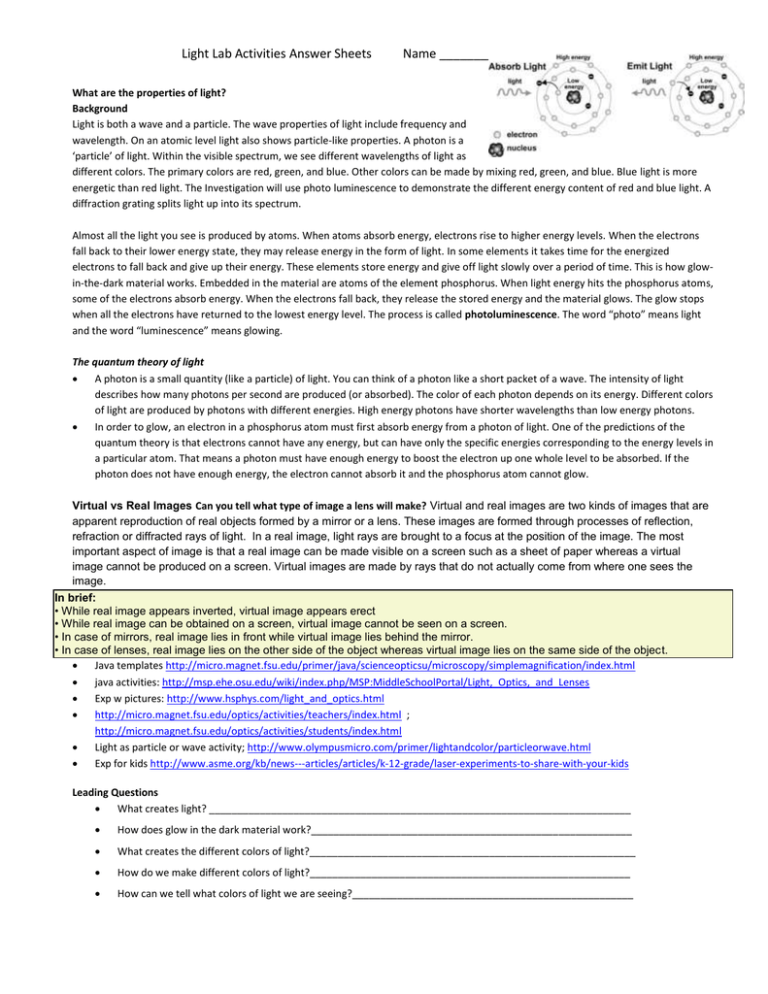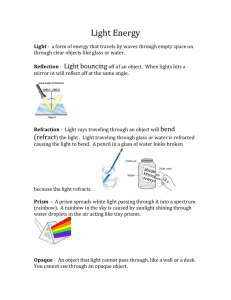Light Lab Activities Answer Sheets Name
advertisement

Light Lab Activities Answer Sheets Name ________________________ What are the properties of light? Background Light is both a wave and a particle. The wave properties of light include frequency and wavelength. On an atomic level light also shows particle-like properties. A photon is a ‘particle’ of light. Within the visible spectrum, we see different wavelengths of light as different colors. The primary colors are red, green, and blue. Other colors can be made by mixing red, green, and blue. Blue light is more energetic than red light. The Investigation will use photo luminescence to demonstrate the different energy content of red and blue light. A diffraction grating splits light up into its spectrum. Almost all the light you see is produced by atoms. When atoms absorb energy, electrons rise to higher energy levels. When the electrons fall back to their lower energy state, they may release energy in the form of light. In some elements it takes time for the energized electrons to fall back and give up their energy. These elements store energy and give off light slowly over a period of time. This is how glowin-the-dark material works. Embedded in the material are atoms of the element phosphorus. When light energy hits the phosphorus atoms, some of the electrons absorb energy. When the electrons fall back, they release the stored energy and the material glows. The glow stops when all the electrons have returned to the lowest energy level. The process is called photoluminescence. The word “photo” means light and the word “luminescence” means glowing. The quantum theory of light A photon is a small quantity (like a particle) of light. You can think of a photon like a short packet of a wave. The intensity of light describes how many photons per second are produced (or absorbed). The color of each photon depends on its energy. Different colors of light are produced by photons with different energies. High energy photons have shorter wavelengths than low energy photons. In order to glow, an electron in a phosphorus atom must first absorb energy from a photon of light. One of the predictions of the quantum theory is that electrons cannot have any energy, but can have only the specific energies corresponding to the energy levels in a particular atom. That means a photon must have enough energy to boost the electron up one whole level to be absorbed. If the photon does not have enough energy, the electron cannot absorb it and the phosphorus atom cannot glow. Virtual vs Real Images Can you tell what type of image a lens will make? Virtual and real images are two kinds of images that are apparent reproduction of real objects formed by a mirror or a lens. These images are formed through processes of reflection, refraction or diffracted rays of light. In a real image, light rays are brought to a focus at the position of the image. The most important aspect of image is that a real image can be made visible on a screen such as a sheet of paper whereas a virtual image cannot be produced on a screen. Virtual images are made by rays that do not actually come from where one sees the image. In brief: • While real image appears inverted, virtual image appears erect • While real image can be obtained on a screen, virtual image cannot be seen on a screen. • In case of mirrors, real image lies in front while virtual image lies behind the mirror. • In case of lenses, real image lies on the other side of the object whereas virtual image lies on the same side of the object. Java templates http://micro.magnet.fsu.edu/primer/java/scienceopticsu/microscopy/simplemagnification/index.html java activities: http://msp.ehe.osu.edu/wiki/index.php/MSP:MiddleSchoolPortal/Light,_Optics,_and_Lenses Exp w pictures: http://www.hsphys.com/light_and_optics.html http://micro.magnet.fsu.edu/optics/activities/teachers/index.html ; http://micro.magnet.fsu.edu/optics/activities/students/index.html Light as particle or wave activity; http://www.olympusmicro.com/primer/lightandcolor/particleorwave.html Exp for kids http://www.asme.org/kb/news---articles/articles/k-12-grade/laser-experiments-to-share-with-your-kids Leading Questions What creates light? ___________________________________________________________________________ How does glow in the dark material work?_________________________________________________________ What creates the different colors of light?__________________________________________________________ How do we make different colors of light?_________________________________________________________ How can we tell what colors of light we are seeing?__________________________________________________ Light Lab Activities Answer Sheets Name ________________________ Learning Goals The student will predict how light will act in different situations, conduct experiments, analyze the results and will draw valid conclusions, citing their supporting information. Topics to be studied include the paths and images presented by plane mirrors, concave lens, convex lens, types of images produced, refraction (including total internal refraction. Place your answers to the lab questions on this answer sheet. Visible Light Spectrum 1. 2. What is the name given to the phenomenon in which white light is separated into its component colors? __________________________________Step 4; Draw a sketch of setup and label the colors you recognize. 3. Step 5; What do you see in the beam emerging from a 2nd prism? _____________________________ 4. Step 6; Make a 2nd sketch and explain what you see. 5. 2. If one examines the stars on a really dark night away from the glare of city lights, some stars appear distinctly reddish in color and others appear brilliant blue> Why does this happen? 6. What is the phenomenon in which white light is separated into its component colors? ______________ Investigating Light and Optics 1. What did Isaac Newton believe about light when he studied it in the 17th Century? 2. What did James Clerk Maxwell believe about light? 3. Sketch an electromagnetic wave. 4. 5. 6. Light waves range from 300 to ___________in wavelength. What is a nanometer?_________________________________________________________ What is the Law of Reflection? __________________________________________________ ___________________________________________________________________________ What is a transverse wave? Pg 2 _________________________________________________ What does it mean to say “We are living with a dualistic interpretation of light? ______________________________________________________________________________ What is a major safety concern when using a laser? ____________________________________ 7. 8. 9. Polarized Light 1. Step 1; Look through one polarized lens. What do you see? Rotate the polarizer and what happens? Record your observations below. Light Lab Activities Answer Sheets Name ________________________ 2. Step 2; Take the second polarizer and hold it next to the first one. What do you see? Rotate the second polarizer and observe what happens. Does the light go out completely for one orientation? Explain your answer. 3. Step 3; It turns out that a skylight is partially polarized when viewed at certain directions. On a bright sunny day, if a window is available, look at the blue sky through the polarizer. CAUTION: Do not look directly at the sun. What do you see? Rotate the polarizer and observe what happens. Record your observations. 4. 5. 6. While a blue skylight is partially polarized, light from clouds is not. Photographers will often enhance their pictures in which the sky is visible by using a polarizing filter on their camera. In the right orientation, the polarizer will darken the sky while leaving the clouds unaffected. This gives more contrast between the clouds and the sky, making for a more striking photograph. Step 4; Some materials possess what is called “optical activity.” When these materials are stressed, they will rotate the plane of polarization. Take a piece of cellophane and crumple it up into a ball and then examine it by placing it in between a pair of polarizers that have been set for no transmission of light. What do you see? Record your results. 1. Explain a behavior of light that characterizers it as a wave___________________________________ ____________________________________________________________________________________ What are some instruments that the concept of polarized light? _______________________________ Lenses Lenses bend light in different directions. The Law of Reflection, states that when an object bounces off a flat surface, the angle at which it hits a flat surface will be equal to the angle at which it bounces away. This angle changes when the surface is not perfectly flat. When a light wave reaches a boundary, like the wall of a container or a piece of glass, it will bend. This is called refraction. Lasers will not show up in air or glass unless something is present to bounce off of. o Illustrate with Plastic Bottle Beam. Fill a clean plastic water or soda bottle with water and add a sprinkle of cornstarch. Turn down the lights and turn on your laser, aiming the beam through the bottle. Do you see the beam in the bottle? _____ Can you find the reflection beam and the pass-through beam? ._________________________________ Instructions 1. 2. 3. Set Up Screen/ lens Light source magnet ___________________ __________________________________ ____ Rail (take measurements) Shine the light through the lenses onto a white screen and then answer the following questions: Use 4 different shaped lenses. Draw a diagram of the path of a laser at 3 points through the lens. If appropriate: Describe how things look through the lens. Ex. Larger, smaller, Upside down, Virtual image, Real image Convex Place the convex lens close to the paper and then slowly move the lens towards the light. (Use either light or laser light to determine if the light rays stay straight, converge or diverge. In what direction do convex lenses bend light? When using a convex lens the image appears___________ (closer or farther away) Draw the paths followed by light through a convex lens. (If using lasers, plot the path of a light beam from a laser through the lens and if applicable, identify the focal point and focal length).







